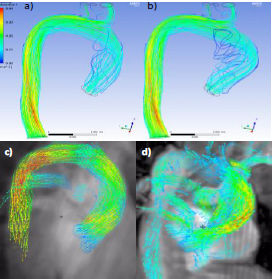
A new application of RBF Morph was presented at The Italian Chapter of the European Society of Biomechanics (ESB-ITA) which held in Rome (Italy) in September 28-29, 2017.
The aim of study is to propose a novel computational approach built up by integrating patient specific images and flow data with RBF morphing techniques into FE simulations
An image-based and RBF mesh morphing CFD simulation for aTAA hemodynamic (K. Capellini, E. Costa, M.E. Biancolini, E. Vignali, V. Positano, L. Landini, and S. Celi).
Abstract
 It is well known that haemodynamic parameters, such as blood flow velocity, blood pressure and wall shear stress (WSS), are closely related with the pathophysiology of aortic diseases. However, the data regarding the formation and the progression of the bulge are still difficult to be obtained in a clinical setting. In this study, 3D surface models defined from healthy subjects and patients with ascending thoracic aorta aneurysms (aTAA), selected for surgical repair, have been generated. A representative shape model for both healthy and pathological groups has been identified. A morphing technique based on radial basis functions (RBF) has been applied to mould the shape relative to healthy patient into the representative shape of aTAA dataset so as to enable the parametric simulation of the aTAA formation. CFD simulations were performed by means of a finite volume solver using the mean boundary conditions obtained from three-dimensional (PC-MRI) acquisition.
It is well known that haemodynamic parameters, such as blood flow velocity, blood pressure and wall shear stress (WSS), are closely related with the pathophysiology of aortic diseases. However, the data regarding the formation and the progression of the bulge are still difficult to be obtained in a clinical setting. In this study, 3D surface models defined from healthy subjects and patients with ascending thoracic aorta aneurysms (aTAA), selected for surgical repair, have been generated. A representative shape model for both healthy and pathological groups has been identified. A morphing technique based on radial basis functions (RBF) has been applied to mould the shape relative to healthy patient into the representative shape of aTAA dataset so as to enable the parametric simulation of the aTAA formation. CFD simulations were performed by means of a finite volume solver using the mean boundary conditions obtained from three-dimensional (PC-MRI) acquisition.
The paper can be download in the Presentations and Proceedings 2017.
